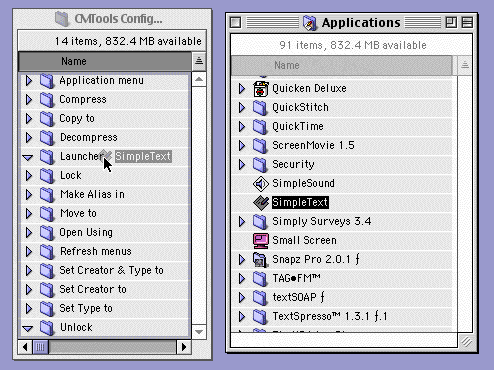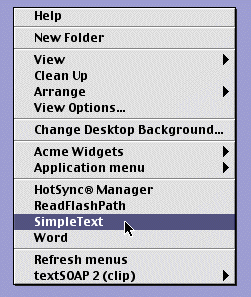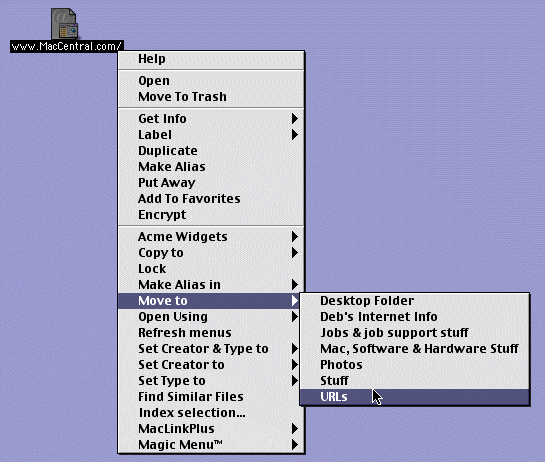CMTools
Written and published February 16, 2000
Ever since Apple came up with Contextual menus I've been a fan of a simple freeware called CMTools, written by Eric de la Musse. For a long time I've wanted to tell you about it. So now's the time.
Contextual menus are the ones that pop up when you press the Control key as you click on the Desktop or any item on your Mac. In a contextual menu, the menu items are built in context to what you're doing. For example, if you're Control-clicking on a file, the file can be moved so choices may include places to which you might move that file. But your Desktop can't be moved so when you Control-click on the Desktop you won't be bothered by file-movement commands or destinations.
The Power of CMTools
CMTools gives you the ability to launch, copy or move files, create aliases, compress or decompress files, and even alter file types. All with a simple Control-click. Here's what CMTools can do for you.
CMTools provides 14 functions.
- Launcher: lets you launch applications.
- Make Alias in: creates an alias and places it in the chosen folder automatically.
- Copy to: makes a copy of your file and places it in the chosen folder automatically.
- Move to: moves the file into the selected folder.
- Decompress: decompresses the file or folder using whatever decompression utility you have in the Decompress folder. (StuffIt Expander or ZipIt for example.)
- Compress: compresses the file or folder using whatever compression utility (such as StuffIt Expander or ZipIt) that you have in the Compress folder.
- Open Using: opens the program using whichever application you pick from this option's submenu.
- Set Creator to: changes the creator codes to that of whichever application you pick from this option's submenu.
- Set Type to: changes the file type to that of whichever file you pick from this option's submenu.
- Set Creator & Type to: does the jobs of the last two features at the same time. In other words, it changes both the file type and creator code to that of whichever file you pick from this option's submenu.
- Lock: locks the file so it can't be altered. Use this when you want to prevent people from saving over a file. Users can still do a Save As but the Save becomes disabled.
- Unlock: unlocks the file so it can be saved over.
- Refresh menus: updates the CMTool's menus after you've added to the CMTools folders if your changes don't appear right away in the Contextual menu.
- Application menu: presents everything that appears under the Finder's Application Menu. This just gives you easier access to all running programs without making you travel to the top right corner of your screen.
Want to try it? Then download it from Eric's site and give it a go.
Setting Up & Using CMTools
Some of CMTools' features are ready to go as-is. Others are customizable. The secret of CMTools customizable features is just to simply create an alias of the desired file and place that alias in the appropriate folder. Remember, the quickest way to create an alias is to press Option and Command as you drag the original over to its target destination. It's easy. Feel free to follow along to do a few setups with me.
To customize the CMTools setup start with this:
- Open your hard drive
- Open the System folder. (Remember that pressing Option as you double-click the System folder automatically closes the hard drive window and avoids screen clutter.)
- Open the Contextual Menu Items folder (pressing Option again)
- Open the folder called CMTools Configuration (pressing Option again). Leave that folder open on your desktop and set it to View as List, sorted by Name. (You'll find a file called CMTools there too. That's the file that enables the pop-up menu to happen.)
- Now you're ready to place aliases into any of the 14 function folders. For now let's set up CMTools so you can Control-click to launch SimpleText.
- Let's continue:
- Locate your SimpleText application. (If you're well organized it's in your Applications folder.) Place it's enclosing folder somewhere so you can still see the Contextual Menu Items folder.
- Pressing Option and Command, click once to select SimpleText and keep the mouse down. Then drag over to the Contextual Menu Items folder, onto the Launcher folder and then release the mouse. You now have an alias of SimpleText in the Launcher folder. (Note: the screen shot isn't 100 percent accurate as I couldn't capture the act of actually making an alias. Your cursor will have a plus sign on its tail.)

From now on, you can Control-click on your Desktop and choose SimpleText from the pop-up menu to launch it. (As in the following screen shot.) Go ahead and try it.

Note: You can also place an alias of a folder into the Launcher folder. When you select that folder from the contextual menu, the folder will open on your screen.
Now lets set CMTools so you'll be able to Control-click on an ILF on your desktop and move it to your URLs folder (assuming you have one).
- Open the folder that contains your URLs folder.
- Pressing Option and Command, click and drag the URLs folder into the Move to folder within the Contextual Menu Items folder. (You're making an alias of the entire URLs folder. In reality, later, you may want to place aliases of specific folders within the URL folder.)
Ready to test this one? You'll need to make an ILF. If your browser is open because you're reading this, and happens to be Internet Explorer, drag the beginning of this URL (http://www.maccentral.com) onto your Desktop. Now Control-click this new IFL and choose URLs from the pop-up menu as shown here. If you don't see this folder in the Move to submenu, Control-click your Desktop and choose Refresh menus. That should tell CMTools you've created the alias.

Now, just for fun let's say you've got a file you don't want to mess up. To ensure that you don't, let's lock that file. Locate any file you want to try this with. Then Control-click on that file and choose Lock from the pop-up menu. There's no submenu for this as you either lock a file or don't. After it's locked, launch the file, make a change, then try to Save the change. The Save menu should be grayed out. See? The file is safe. Lock is a CMTools command that doesn't need customization.
Well, that's the idea. Here's the lowdown on what you put in each CMTools folder.
- Launcher: place an alias of each application you'd like to launch from here. I recommend only putting the most commonly used programs here.
- Make Alias in: place an alias any folder or disk (volume) into which you commonly save aliases. For example, the Apps menu you have under your Apple menu if you followed my earliest columns.
- Copy to: place an alias any folder or volume (disk) into which you commonly save a copy of any files.
- Move to: place an alias any folder into which you commonly store files
- Decompress: if you're using StuffIt Expander to do your decompression place an alias of it here. If you're using StuffIt Deluxe you already have a contextual menu so you don't need this.
- Compress: if you're using DropStuff to do your decompression place an alias of it here. If you're using StuffIt Deluxe you already have a contextual menu so you don't need this. However, you might want to put an alias of ZipIt here to Zip your files when desired.
- Open Using: place an alias of each application you'd like to use for opening other files in. For example, if you use Word as your word processor place its alias here. Then, when someone gives you a Word Perfect file you can Control-click that file and choose Open Using->Word. You can select several files, then Control-click anywhere on the selected files to open multiple files at once.
- Set Creator to: place an alias to applications whose creator code you would like to apply to selected files. The Creator code tells the Finder which program to launch when you double-click the file. It also changes the file's icon. (If you're not sure what this does, pass on this feature for now. I'll explain the creator code later on.)
- Set Type to: place an alias to files whose type code you would like to apply to selected files. (Again, if you're not sure what this does, wait until I explain it later.)
- Set Creator & Type to: place an alias to files whose type and creator codes you would like to apply to the selected file(s). Again, if you're not sure what this does, skip this feature for now.
- Lock: You don't place anything in this folder. You just select this option when you want to prevent people from saving over a file.
- Unlock: You don't place anything in this folder. You just select this option to enable a file to again be changed.
- Refresh menus: You don't place anything in this folder. Just choose it to update the CMTools' menus after making a change.
- Application menu: You don't place anything in this folder. All running programs appear here automatically so you can launch files by Control-clicking on the Desktop. The Finder's Hide and Show commands are also here.
You don't have to take advantage of every feature. If you don't need a feature, just leave that feature's folder empty. When a folder is empty, that folder's function simply doesn't appear when you Control-click on files.
You can also organize the contextual menus. To add a separator after a function or item, just type a hyphen (next to the zero) at the end of its name. When you no longer want a function, just trash the contents of the folder.
CMTools runs on any Power Mac that has at least OS 8.
In case you're wondering, CMTools doesn't compete with Action Menus. It simply provides another option. Use each as appropriate. Depending on the speed of your Mac, you may reach a point where you feel your contextual menus take too long to build and appear. (I find a delay the first time I choose a contextual menu each session, but it seems to speed up after the initial building.) Find the balance between speed, length of the information, and functionality. I distribute things between my Apple menu and the contextual menu, basing each upon use and speed. I'm sure you'll do the same.
Enjoy.
|


